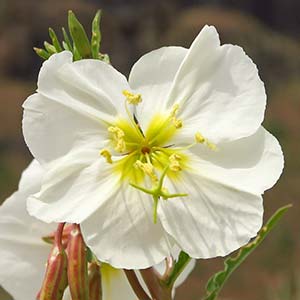Oenothera wolfii
Oenothera pallida
Wolf's evening-primrose
mountain evening primrose, pale evening-primrose, rockweed brush, white-stem evening primrose
erect, green, flushed with red proximally or red throughout, unbranched or branches obliquely arising from rosette and sometimes secondary branches arising from main stem, 50–100 cm.
erect or ascending, single to several from base, unbranched or many-branched throughout, 10–50(–70) cm.
in a basal rosette and cauline, basal 13–35 ×1.5–4(–5) cm, cauline 5–18 × 1–2.5(–4) cm;
blade dull green, flat, oblanceolate to narrowly lanceolate or lanceolate to elliptic, margins bluntly dentate or subentire, teeth widely spaced or sinuate proximally;
bracts persistent.
cauline, rosette usually weakly developed or absent, at least during flowering, sometimes well developed, 1–5(–7.8) × 0.3–1(–1.5) cm;
petiole 0–2(–4.5) cm;
blade lanceolate, oblong, linear-lanceolate, or ovate, margins subentire or remotely denticulate, deeply sinuate-dentate, or pinnatifid, sometimes repand.
erect, unbranched.
opening near sunset;
buds erect, 5–8 mmdiam., with free tips terminal, erect, 1–3 mm;
floral tube 30–46 mm;
sepals yellowish green, also usually flushed with red or red-striped, 17–28 mm;
petals yellow, fading orange, pale yellow and somewhat opaque, very broadly obcordate, 13–23 mm, conspicuously shorter than sepals;
filaments 12–20 mm, anthers 7–12 mm, pollen ca. 50% fertile;
style 43–58 mm, stigma usually slightly exserted beyond anthers or surrounded by them at anthesis.
1–several opening per day near sunset;
buds nodding, weakly quadrangular, with free tips 0–2 mm;
floral tube 15–40 mm;
sepals 10–30 mm, not spotted;
petals white, fading pink to deep pink, broadly obovate or obcordate, (10–)15–25(–40) mm;
filaments 9–15 mm, anthers 3–10 mm;
style 25–55 mm, stigma exserted beyond anthers at anthesis.
erect or slightly spreading, dark dull green and sometimes red-striped when dry, narrowly lanceoloid, 30–48 × 5–7 mm, free tips of valves 0.5–2.5mm.
spreading to reflexed, straight to curved or contorted, cylindrical, obtusely 4-angled, tapering slightly from base to apex, 15–60 × 1.5–2.5 mm;
sessile.
0.9–2 × 0.9–1.3 mm.
numerous, in 1 row per locule, brownish with dark spots or black, narrowly obovoid, 1.5–2.2 mm.
= 14.
Oenothera wolfii
Oenothera pallida
Oenothera wolfii is a PTH species and forms a ring of 14 chromosomes in meiosis, and is self-compatible and autogamous (W. Dietrich et al. 1997). It has plastome I and a AA genome composition. It is known only from the vicinity of Port Orford, Curry County, Oregon (currently apparently only as far north as Otter Rock), south in a scattered distribution through Del Norte County to the mouth of the Mattole River, Humboldt County, California. The distribution, at least in California, is closely associated with small patches of Cenozoic-age marine sediments, isolated from each other by Franciscan sedimentary and metamorphic rocks. Most populations appear to occur near river mouths or to the south of a headland. The largest populations center in the area about 11 km long in the vicinity of Crescent City in Del Norte County, between Point George and Enderts Beach in Redwood National Park. There are collections from two inland California localities, one at the eastern border of Humboldt County, California (Willow Creek, Trinity River Valley), and the other at Carville, Trinity County, that may be O. wolfii. If so, they would presumably represent recent introductions and should be studied further. As summarized by Dietrich et al., O. wolfii is a rare endemic of coastal habitats and known from about 20 different sites. The total number of individuals of O. wolfii apparently fluctuates, with perhaps no more than about 5000 individuals total. It is threatened by any potential development and alteration of its habitat, presently by road maintenance and foot traffic. Another possibly more serious threat comes from the recent spread of O. glazioviana to this area. Oenothera glazioviana could swamp populations through hybridization and, perhaps, by direct competition.
Oenothera wolfii is in the Center for Plant Conservation’s National Collection of Endangered Plants.
(Discussion copyrighted by Flora of North America; reprinted with permission.)
Subspecies 4 (4 in the flora).
Oenothera pallida is a poorly understood species currently subdivided into four subspecies (W. L. Wagner et al. 2007) that differ largely in aspect, leaf division, capsule configuration, and pubescence. The variation pattern is rather complex with almost no diagnostic character uniformly distinguishing any one of the subspecies. Instead, each of the subspecies, which are mostly geographically separated although there is some level of overlap, have diagnostic suites of characters that maintain their linkage some of the time, but break down across the geographic area of each so that no single character uniquely identifies it. Each subspecies is characterized by leaf, pubescence, and, often, habit features. The issues with the integrity and intergradations of the subspecies are discussed below.
Oenothera pallida has been determined to be self-incompatible (W. L. Wagner et al. 2007), but K. E. Theiss et al. (2010) determined that although most populations of subsp. pallida are self-incompatible, one near Salt Lake City is self-compatible.
(Discussion copyrighted by Flora of North America; reprinted with permission.)
1. Herbs annual, sometimes perennial from a taproot, when perennial, sometimes with lateral roots producing adventitious shoots, strigillose throughout and villous distally, especially on flower parts. | subsp. trichocalyx |
1. Herbs perennial from a taproot and with lateral roots producing adventitious shoots, glabrous, strigillose, or sparsely villous. | → 2 |
2. Plants glabrous, sometimes strigillose, rarely sparsely villous; leaf blade margins usually subentire or remotely denticulate, rarely pinnatifid; capsules usually contorted to curved. | subsp. pallida |
2. Plants usually strigillose, rarely villous or glabrous; leaf blade margins shallowly sinuate-dentate or denticulate, or deeply sinuate-dentate to pinnatifid, rarely only dentate; capsules usually straight or curved, sometimes contorted. | → 3 |
3. Leaf blades (0.4–)0.7–1.5 cm wide, margins shallowly sinuate-dentate or denticulate. | subsp. latifolia |
3. Leaf blades 0.4–1(–1.5) cm wide, margins usually deeply sinuate-dentate to pinnatifid, rarely dentate only. | subsp. runcinata |


